
Frederick County is located in the Commonwealth of Virginia. As of the 2020 census, the population was 91,419. Its county seat is Winchester. The county was formed in 1743 by the splitting of Orange County. It is Virginia's northernmost county. Frederick County is included in the Winchester, VA-WV Metropolitan Statistical Area, which is also included in the Washington-Baltimore-Northern Virginia, DC-MD-VA-WV-PA Combined Statistical Area.

The Delaware, Lackawanna and Western Railroad, also known as the DL&W or Lackawanna Railroad, was a U.S. Class 1 railroad that connected Buffalo, New York, and Hoboken, New Jersey, and by ferry with New York City, a distance of 395 miles (636 km). The railroad was incorporated in Pennsylvania in 1853, and created primarily to provide a means of transport of anthracite coal from the Coal Region in Northeast Pennsylvania to large coal markets in New York City. The railroad gradually expanded both east and west, and eventually linked Buffalo with New York City.

The EMD SD60 is a 3,800 horsepower (2,800 kW), six-axle diesel-electric locomotive built by General Motors Electro-Motive Division, intended for heavy-duty drag freight or medium-speed freight service. It was introduced in 1984, and production ran until 1995.
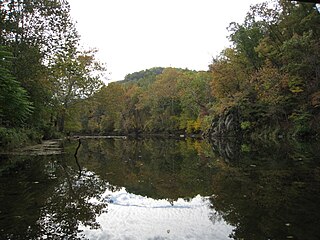
The Cacapon River, located in the Appalachian Mountains of West Virginia's Eastern Panhandle region, is an 81.0-mile-long (130.4 km) shallow river known for its fishing, boating, wildlife, hunting, and wilderness scenery. As part of the Potomac River watershed, it is an American Heritage River.

West Virginia Route 259 is a state highway in the U.S. state of West Virginia. The state highway runs 45.6 miles (73.4 km) from the Virginia state line near Mathias north to the Virginia state line at High View. At both termini, the road continues as Virginia State Route 259. WV 259 passes through Hardy and Hampshire counties and runs concurrently with WV 55 on Corridor H between Baker and Wardensville.
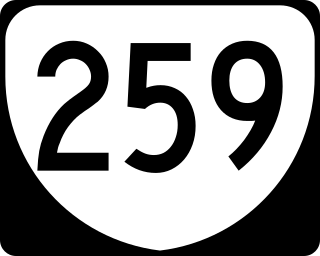
State Route 259 is a primary state highway in the U.S. state of Virginia. The state highway runs a total of 26.80 miles (43.13 km) in two sections. The southern section, in northern Rockingham County, has a length of 21.81 miles (35.10 km) from Interstate 81 (I-81) and U.S. Route 11 at Mauzy through Broadway to the West Virginia state line into Mathias. The northern section, in western Frederick County, covers 4.99 miles (8.03 km) from the West Virginia state line north to US 50 at Gore. The two sections of SR 259 are joined by West Virginia Route 259.
Back Creek is a 59.5-mile-long (95.8 km) tributary of the Potomac River that flows north from Frederick County, Virginia, to Berkeley County in West Virginia's Eastern Panhandle. Back Creek originates along Frederick County's border with Hampshire County, West Virginia, at Farmer's Gap in the Great North Mountain. Its name reflects its location to the west of North Mountain. The perspective of colonists from the east in the 18th century led them to call it "Back Creek", because it lay to the back of North Mountain.
Rock Enon Springs is an unincorporated community in Frederick County, Virginia. United States. Rock Enon Springs is located 18 miles west of Winchester on Rock Enon Springs Road off Back Creek Road south of Gore. The community was known for its Rock Enon Springs Resort, which was sold in 1945 and is now owned by the Boy Scouts as Camp Rock Enon. Rock Enon Springs had a station along the Winchester and Western Railroad until the 1930s, when the railroad was shortened to Gore.

The passenger locomotives derivatives of the General Motors EMD GP40 diesel-electric locomotive have been, and continue to be, used by multiple passenger railroads in North America. For passenger service, the locomotives required extra components for providing steam or head-end power (HEP) for heating, lighting and electricity in passenger cars. Most of these passenger locomotives were rebuilt from older freight locomotives, while some were built as brand new models.

The New England Central Railroad is a regional railroad in the New England region of the United States. It began operations in 1995, as the successor of the Central Vermont Railway (CV). The company was originally a subsidiary of holding company RailTex before being purchased by RailAmerica in 2000. In 2012, the company was purchased by Genesee & Wyoming, its current owner.

The High Bridge Branch is a branch line that was operated by the Central Railroad of New Jersey (CNJ). As built, the branch started in High Bridge, New Jersey at a connection with the CNJ main line and continued north to iron-ore mines in Morris County. The High Bridge Branch line followed the South Branch of the Raritan River for much of its duration.
B&H Rail Corporation, formerly the Bath & Hammondsport Railroad, is a Class III shortline railroad. Initially the line served the communities of Bath, New York and Hammondsport, New York. In Bath, the railroad connected with the Erie Railroad and the Delaware, Lackawanna and Western Railroad. In 1996, the railroad was leased by the Livonia, Avon and Lakeville Railroad.

The Belvidere & Delaware River Railway Company also known as Delaware River Railroad is a class III railroad in the United States. It was formed in 1995 when the Conrail Delaware Secondary line was purchased by the Black River Railroad System, which operates several railroad services in western New Jersey and eastern Pennsylvania. The Black River Railroad System also owns and operates the Black River & Western Railroad (BR&W). BR&W leases 10 miles of track to BDRV since 2004. Trackage purchased was a segment of the original Belvidere Delaware Railroad, later controlled by the Pennsylvania Railroad, Penn Central, then Conrail.
The Manassas Gap Railroad (MGRR) ran from Mount Jackson, Virginia, to the Orange and Alexandria Railroad's Manassas Junction, which later became the city of Manassas, Virginia. Chartered by the Virginia General Assembly in 1850, the MGRR was a 4 ft 8 in narrow gauge line whose 90 completed miles of track included 38 miles (61 km) of 60 pounds-per-yard T-rail and 52 miles (84 km) of 52 pounds-per-yard T-rail. A total of nine locomotives and 232 cars were operated on the line, serving 20 stations.
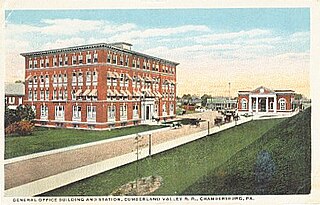
The Cumberland Valley Railroad was an early railroad in Pennsylvania, United States, originally chartered in 1831 to connect with Pennsylvania's Main Line of Public Works. Freight and passenger service in the Cumberland Valley in south central Pennsylvania from near Harrisburg to Chambersburg began in 1837, with service later extended to Hagerstown, Maryland, and then extending into the Shenandoah Valley to Winchester, Virginia. It employed up to 1,800 workers.

The Everett Railroad is a shortline and heritage railroad that operates on ex-Pennsylvania Railroad trackage in the Hollidaysburg area of the U.S. state of Pennsylvania. It runs freight trains over two separate lines, one from Brooks Mill and Sproul, and the other, owned by the Morrison's Cove Railroad, from Roaring Spring to Curryville and Martinsburg.
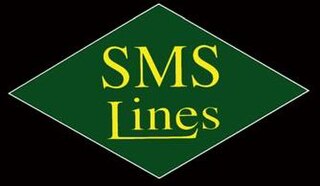
SMS Rail Lines is a shortline railroad based at Pureland Industrial Park in Bridgeport, New Jersey. The company handles all freight car delivery to businesses located within the industrial park. It also operates lines in Morrisville, Pennsylvania, and Guilderland, New York. Guilderland-based operations operate as SMS Rail Lines of New York, LLC. SMS maintains many locomotives built by the Baldwin Locomotive Works. SMS provides chemical off-loading equipment and transload facilities to enable businesses to receive rail freight traffic.
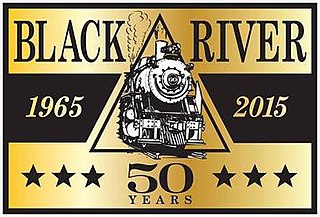
The Black River and Western Railroad is a freight and heritage railroad operating in Hunterdon County, New Jersey, between Flemington, Lambertville and Ringoes. The railroad operates vintage steam and diesel powered locomotives.

William Benjamin Cornwell was an American lawyer, businessperson, newspaper editor and publisher, and railroad and timber executive in the U.S. state of West Virginia. He was an older brother of writer and newspaper publisher Marshall S. Cornwell (1871–1898) and of West Virginia Governor John J. Cornwell (1867–1953).
The Delmarva Central Railroad is an American short-line railroad owned by Carload Express that operates 188 miles (303 km) of track on the Delmarva Peninsula in the states of Delaware, Maryland, and Virginia. The railroad operates lines from Porter, Delaware to Hallwood, Virginia and from Harrington, Delaware to Frankford, Delaware along with several smaller branches. The DCR interchanges with the Norfolk Southern Railway and the Maryland and Delaware Railroad. The railroad was created in 2016 to take over the Norfolk Southern Railway lines on the Delmarva Peninsula. The DCR expanded by taking over part of the Bay Coast Railroad in 2018 and the Delaware Coast Line Railroad in 2019.

















